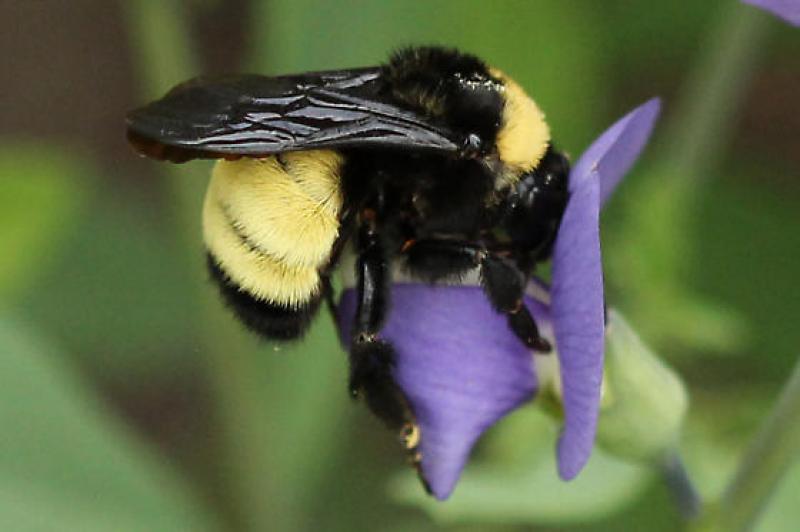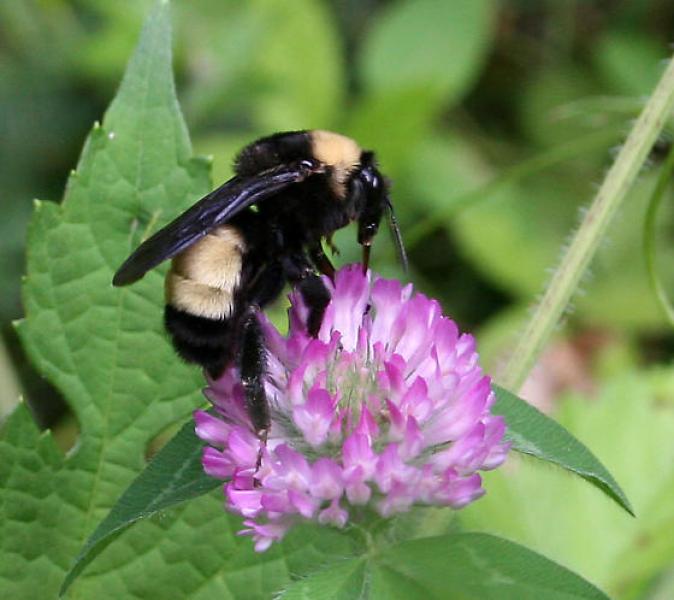American Bumble Bee
Bombus pensylvanicus (De Geer, 1773)
- Class
- Insecta (Insects)
- Family
- Apidae (Triepeolus)
- State Protection
- Not Listed
Not listed or protected by New York State.
- Federal Protection
- Not Listed
- State Conservation Status Rank
- S2
Imperiled in New York - Very vulnerable to disappearing from New York due to rarity or other factors; typically 6 to 20 populations or locations in New York, very few individuals, very restricted range, few remaining acres (or miles of stream), and/or steep declines.
- Global Conservation Status Rank
- G3G4
Vulnerable globally, or Apparently Secure - At moderate risk of extinction, with relatively few populations or locations in the world, few individuals, and/or restricted range; or uncommon but not rare globally; may be rare in some parts of its range; possibly some cause for long-term concern due to declines or other factors. More information is needed to assign either G3 or G4.
Summary
Did you know?
Bumble bees are not as aggressive as other types of bees, wasps, and hornets and rarely sting unless their nest is disturbed (Schweitzer et al. 2012).
State Ranking Justification
The American Bumble Bee has suffered rapid, recent declines in New York and has been confirmed in eleven counties in NY (year 2000 to present) but was once common statewide (Colla et al. 2012, White et al. 2022). Its decline has been attributed mainly to exotic pathogens and insecticide use, but it also faces other threats (Schweitzer et al. 2012, Cameron et al. 2011).
Short-term Trends
Short-term trends for the species are unknown.
Long-term Trends
Based on data from the Empire State Native Pollinator Survey, the current (2000 to present) and historical (1999 and earlier) distribution in NY has declined by more than half of their distribution. While the species was once known from several counties statewide, recent observations have been made in only eleven counties (White et al. 2022).
Conservation and Management
Threats
The primary threat to species in the subgenus Thoracobombus leading to their rapid, recent decline in the 1990s has been attributed to exotic pathogens. Cameron et al. (2011) showed a higher proportion of B. pensylvanicus individuals infected by the pathogen Nosema bombi than other bumble bees with stable global populations. In addition, habitat loss, insecticides, and urbanization are known long-term threats for many bumble bees (Schweitzer et al. 2012).
Conservation Strategies and Management Practices
Any efforts to protect wild bumble bee populations from pathogen exposure would benefit American Bumble Bees. Suggested actions would include using mesh to prevent escape of bees from commercial breeding greenhouses, proper disposal of commercial bees, sanitation in greenhouses, and development of molecular screening. Tight restrictions on importing bumble bees and elimination of parasites from commercial populations has been suggested as ideal (Meeus et al. 2011, Schweitzer et al. 2012).
Limiting exposure of American Bumble Bee to insecticides would also benefit them. Suggested actions include avoidance of application to flowers that bumble bees are attracted to and application of solutions or soluble powders (rather than dusts or wettable powders) to the ground in calm wind and warmer temperatures during periods of dewless nights to minimize the impact to resident bumble bee populations (Schweitzer et al. 2012). Organic farming has also been suggested to benefit bumble bees.
Ensuring habitat resources for foraging, nesting, and overwintering will also benefit B. pensylvanicus. Habitats for these needs should be within close proximity to each other and without road or railroads between them, which may be barriers to dispersal. Suggested actions for habitat management should include ensuring nectar availability throughout the spring and summer by improving flower abundance and species richness and species with overlapping blooms. Select food plants for B. pensylvanicus include vetches, clovers, goldenrods, Hypericum, and Eupatorium (Colla et al. 2011). If mowing of fields occurs, summer is the best time and mower blades should be raised to avoid ground nests. Staggering cutting times in different field areas will ensure nectaring sources are always available. Increasing available nesting habitat may be accomplished by reducing tillage in fields, leaving unplowed strips vegetated, or even providing artificial nesting boxes. Managing for rodents and ground-nesting birds should also benefit bumble bees (Schweitzer et al. 2012).
Research Needs
Further research is needed to determine more information on habitat requirements, threats, climate change effects, and insecticide effects for American Bumble Bee.
Habitat
Habitat
Bumble bees are generalist foragers and need nesting habitat in the spring, flowers for adult and larval nutrition throughout the spring and summer, and sites for queens to overwinter. Bumble bees that nest above ground such as this species often use long grass or hay stacks. Foraging habitat should include flower abundance and species richness with overlapping blooms to ensure nectar availability throughout the growing season (Schweitzer et al. 2012). Select food plants for B. pensylvanicus include vetches, clovers, goldenrods, Hypericum, and Eupatorium(Colla et al. 2011). Suitable sites for bumble bees to overwinter may include rotting logs, mulch, or loose soil (Schweitzer et al. 2012).
Range
New York State Distribution
The American Bumble Bee has suffered rapid, recent declines in New York and has been confirmed in eleven counties in NY (year 2000 to present) but was once common statewide (Colla et al. 2012, White et al. 2022). Its decline has been attributed mainly to exotic pathogens and insecticide use, but it also faces other threats (Schweitzer et al. 2012, Cameron et al. 2011).
Global Distribution
Before 1998, American bumble bee was known from southern Quebec and Ontario west to South Dakota, south to Texas, California, and Mexico and east to Florida. Its more recent range appears to have contracted to Ontario, Quebec and a smattering of states across the U.S. (NatureServe 2023).
Identification Comments
Identifying Characteristics
American Bumble Bee queens and workers have yellow hair on the front of the thorax and abdominal segments two and three and the rear edge of segment one. Other areas are black. Males have similar coloration to females, with the addition of yellow hair on the rear of the thorax and yellow on abdominal segments one through five (Colla et al. 2011, Evans 2009).
Best Time to See
Bumble bee queens hibernate over the winter, emerge in the spring, locate a nest site, and rear young (workers, males, and new queens). After new queens and males mate, all males, workers, and old queens die by the beginning of winter and new queens settle into sites to overwinter (Schweitzer et al. 2012).
- Active
- Reproducing
The time of year you would expect to find American Bumble Bee active and reproducing in New York.
Similar Species
- Black and Gold Bumble Bee (Bombus auricomus)
(guide)
Black and Gold Bumble Bees have yellow hair on top of their head, while American bumble bees have black hair here. Both species (with workers and queens) have yellow hair on abdominal segments two and three, but American bumble bees have yellow at the rear edge of the first segment too (Evans et al. 2009).
- Yellow-banded Bumble Bee (Bombus terricola)
(guide)
Yellow-banded workers and queens have yellow on abdominal segments two and three and a fringe of brownish yellow hair on the far edge of the fifth segment. American Bumble Bees have yellow at the rear edge of the first abdominal segment as well as segments two and three and lack the fringe on the fifth segment. Male Yellow-banded have black hair on the rear of the thorax, but American males have yellow hair here (Evans et al. 2009).
American Bumble Bee Images
Taxonomy
American Bumble Bee
Bombus pensylvanicus (De Geer, 1773)
- Kingdom Animalia
- Phylum Arthropoda
(Mandibulates)
- Class Insecta
(Insects)
- Order Hymenoptera
(Bees, Wasps, Ants, Sawflies)
- Family Apidae (Triepeolus)
- Order Hymenoptera
(Bees, Wasps, Ants, Sawflies)
- Class Insecta
(Insects)
- Phylum Arthropoda
(Mandibulates)
Additional Resources
References
Bachman, S., J. Moat, A. Hill, J. de la Torre, and B. Scott. 2011. Supporting red list threat assessments with GeoCAT: geospatial conservation assessment tool. In: Smith, V. and L. Penev (Eds) e-Infrastructures for data publishing in biodiversity science. ZooKeys 150: 117-126. (Version BETA). Available online at: https://www.kew.org/science/our-science/projects/geocat-geospatial-conservation-assessment-tool.
Cameron, S.A., J.D. Lozier, J.P. Strange, J.B. Koch, N. Cordes, L.F. Solter, and T.L. Griswold. 2011. Patterns of widespread decline in North American bumble bees. PNAS. 108 (2): 662-667.
Colla, S. R., F. Gadallah, L. Richardson, D. Wagner, and L. Gall. 2012. Assessing declines of North American bumble bees (Bombus spp.) using museum specimens. Biodiversity and Conservation 21:3585–3595.
Colla, S., L. Richardson, and P. Williams. 2011. Bumble bees of the eastern United States.
Evans, E. 2009. Pocket guide to identifying the yellowbanded bumble bee (Bombus terricola). The Xerces Society for Invertebrate Conservation. Accessed at http://www.xerces.org/wp-content/uploads/2009/02/terricola_pocketid1.pdf.
Meeus, I., Brown, M.J.F., DeGraaf, D.C., and G. Smagghe. 2011. Effects of invasive parasites on bumble bee declines. Conservation Biology 25(4): 662-671.
NatureServe. 2023. NatureServe Network Biodiversity Location Data accessed through NatureServe Explorer [web application]. NatureServe, Arlington, Virginia. Available https://explorer.natureserve.org/.
New York Natural Heritage Program. 2024. New York Natural Heritage Program Databases. Albany, NY.
Richardson, L. 2013. Compilation of specimen records for Bombus species of North America from the American Museum of Natural History, Harvard Museum of Comparative Zoology, among several other museums. Unpublished data.
Schweitzer, D. and N. Sears. May 1, 2013. Bumble bee ranking guidelines. NatureServe, Arlington, VA.
Schweitzer, D.F., N.A. Capuano, B.E. Young and S.R. Colla. 2012. Conservation and management of North American bumble bees. NatureServe, Arlington, Virginia, and USDA Forest Service, Washington, D.C. 17 pp.
White, Erin L., Matthew D. Schlesinger, and Timothy G. Howard. 2022. The Empire State Native Pollinator Survey (2017-2021). New York Natural Heritage Program. Albany, NY.
Yanega, D. 2013. Compilation of specimen records for Bombus species of North America from the University of California Riverside Entomology Research Museum, the Essig Museum of Entomology, University of California Berkeley, the Natural History Museum of Los Angeles County and the California State Collection of Arthropods. Unpublished data.
Links
About This Guide
This guide was authored by: Erin L. White
Information for this guide was last updated on: September 19, 2023
Please cite this page as:
New York Natural Heritage Program. 2024.
Online Conservation Guide for
Bombus pensylvanicus.
Available from: https://guides.nynhp.org/american-bumble-bee/.
Accessed July 26, 2024.

